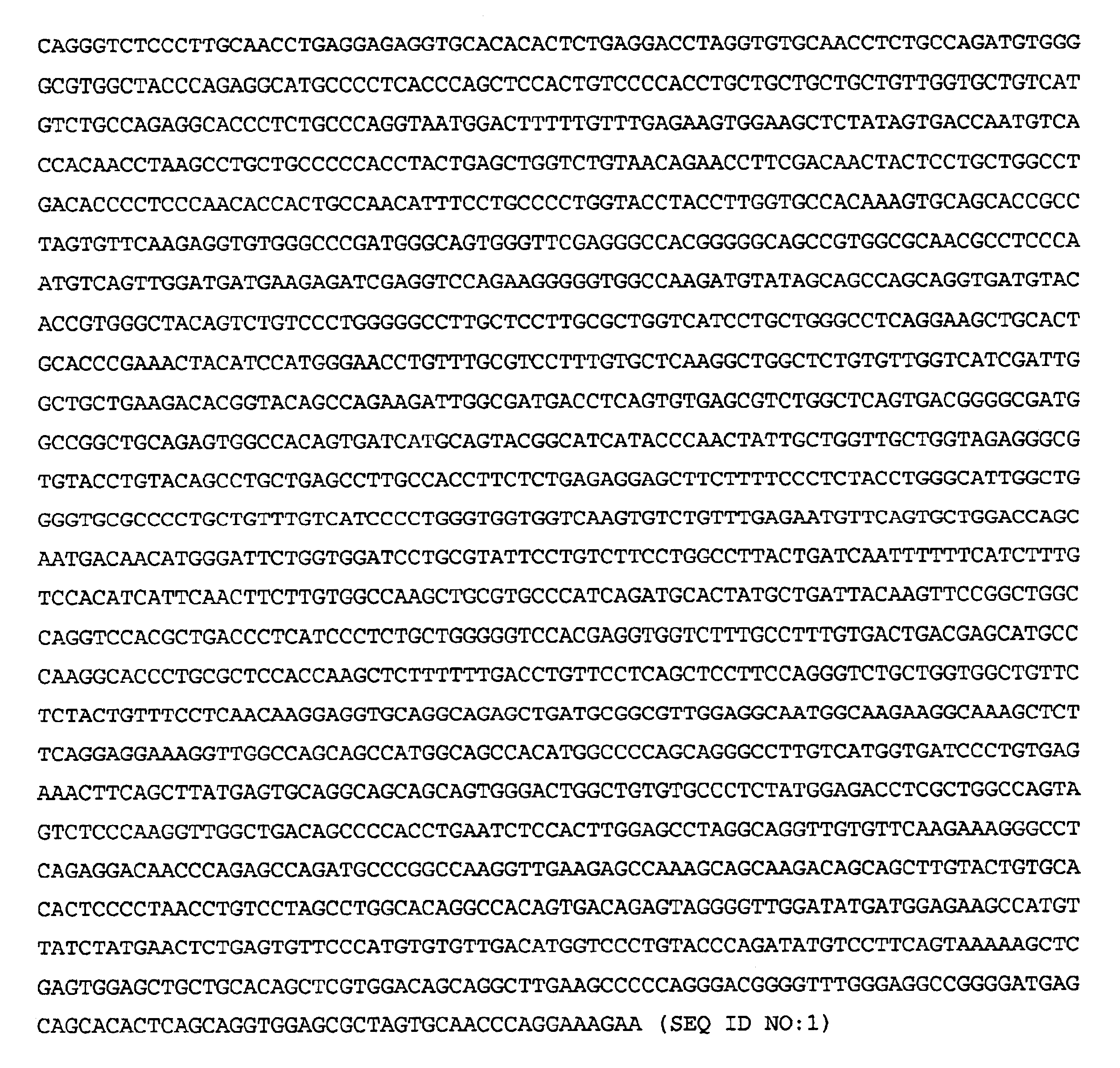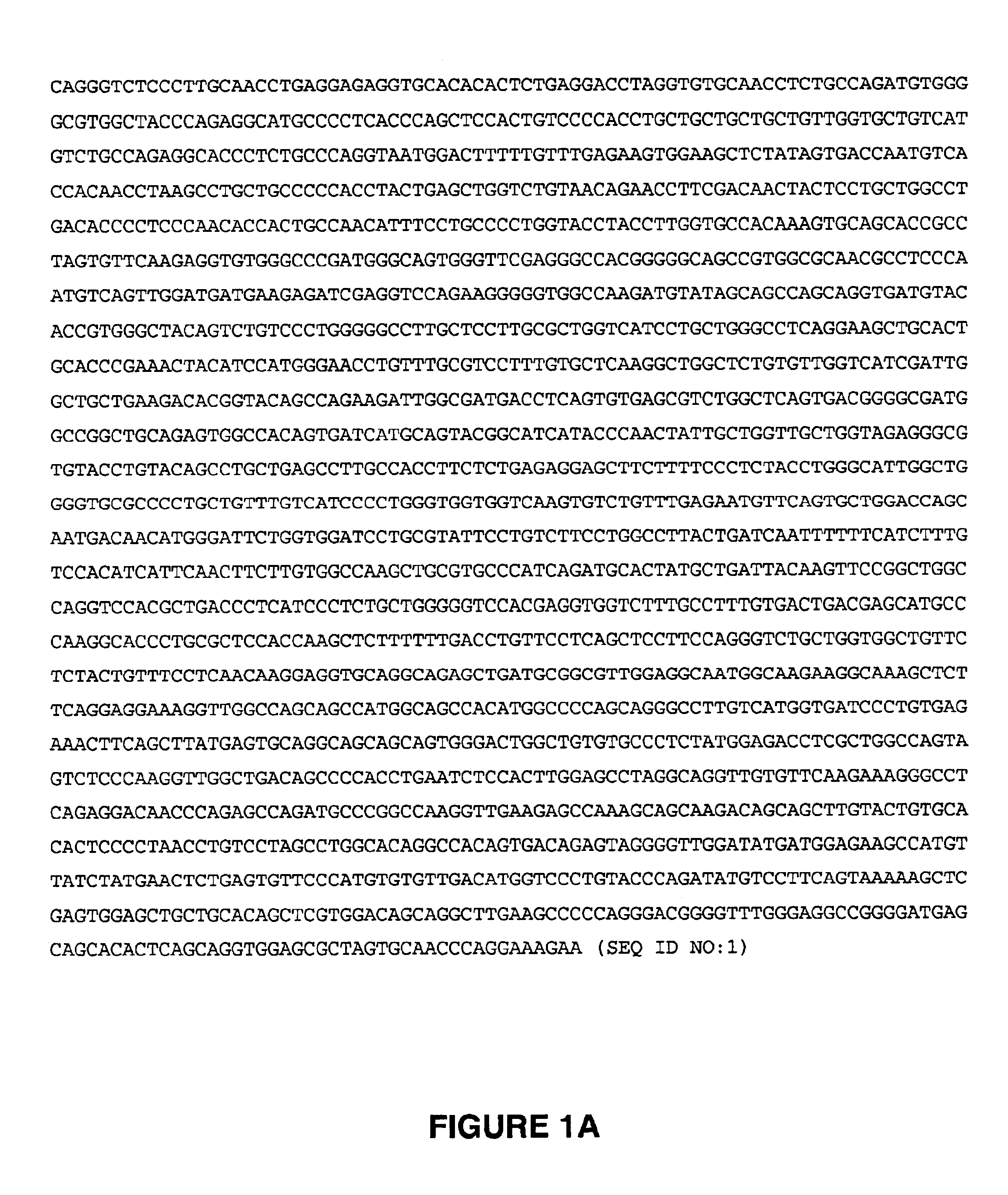Transgenic mice containing glucagon receptor gene disruptions
a technology of glucagon receptor and transgenic mice, which is applied in the field of transgenic animals, can solve the problems of impaired glucose tolerance, organ damage, chronic hyperglycemia, and tissue damag
- Summary
- Abstract
- Description
- Claims
- Application Information
AI Technical Summary
Benefits of technology
Problems solved by technology
Method used
Image
Examples
example 1
Generation of Mice Comprising Glucagon Receptor Gene Disruptions
[0200]To investigate the role of glucagon receptors, disruptions in glucagon receptor genes were produced by homologous recombination. Specifically, transgenic mice comprising disruptions in glucagon receptor genes were created. More particularly, as shown in FIG. 2, a glucagon receptor targeting construct having the ability to disrupt a glucagon receptor gene was created, using as the targeting in the construct the oligonucleotide sequences identified herein as SEQ ID NO:3 or SEQ ID NO:4.
[0201]The targeting construct was introduced into ES cells derived from the 129 / OlaHsd mouse substrain to generate chimeric mice. The F1 mice were generated by breeding with C57Bu6 females, and the resultant F1NO heterozygotes were backcrossed to C57BL / 6 mice to generate F1N1 heterozygotes. The F2N1 homozygous mutant mice were produced by intercrossing F1N1 heterozygous males and females.
[0202]The transgenic mice comprising disruptions...
example 2
[0203]RT-PCR Expression. Total RNA was isolated from the organs or tissues from adult C57BL / 6 wild-type mice. RNA was DNaseI treated, and reverse transcribed using random primers. The resulting cDNA was checked for the absence of genomic contamination using primers specific to non-transcribed genomic mouse DNA. cDNAs were balanced for concentration using HPRT primers. RNA transcripts were detectable in liver, kidney, gall bladder, adrenal gland and salivary gland. RNA transcripts were not detectable in brain, cortex, subcortical region, cerebellum, brainstem, olfactory bulb, eye, heart, lung, pancreas, spleen, thymus, lymph nodes, bone marrow, skin, urinary bladder, pituitary gland, skeletal muscle, tongue, stomach, small intestine, large intestine, cecum, testis, epididymis, seminal vesicle, coagulating gland, prostate gland, ovary and uterus.
example 3
Analysis of Transgenic Mice
[0204]Histopathology: When compared to age- and gender-matched wild-type control mice, the transgenic mice comprising disruptions in the glucagon receptor displayed changes in the Islets of Langerhans cells of the pancreas at about 49 days of age. Specifically, all homozygous mutant female mice, three out of four homozygous mutant male mice, and one heterozygous mutant male mouse displayed mild to moderate hyperplasia and hypertrophy of the Islet cells, as well as increased cytoplasmic vacuolization and granularity. In addition, it was observed that one homozygous mutant male mouse displayed thymic atrophy and marked testicular immaturity, and this mouse was clinically identified as a dwarf.
[0205]Normal Islets of Langerhans cells are predominantly composed of insulin-secreting β-cells, with a narrow rim of glucagon-secreting α-cells, and a scattering of somatostatin-secreting δ-cells. Immunohistochemistry performed on tissues from homozygous animals demons...
PUM
| Property | Measurement | Unit |
|---|---|---|
| size | aaaaa | aaaaa |
| concentrations | aaaaa | aaaaa |
| amino-acid | aaaaa | aaaaa |
Abstract
Description
Claims
Application Information
 Login to View More
Login to View More - R&D
- Intellectual Property
- Life Sciences
- Materials
- Tech Scout
- Unparalleled Data Quality
- Higher Quality Content
- 60% Fewer Hallucinations
Browse by: Latest US Patents, China's latest patents, Technical Efficacy Thesaurus, Application Domain, Technology Topic, Popular Technical Reports.
© 2025 PatSnap. All rights reserved.Legal|Privacy policy|Modern Slavery Act Transparency Statement|Sitemap|About US| Contact US: help@patsnap.com



